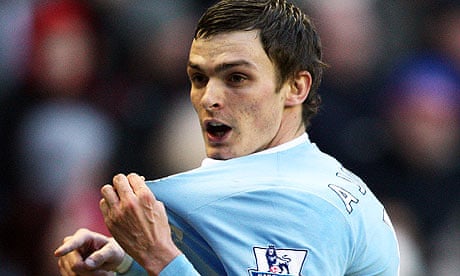There's an episode of Porridge in which the inmates receive a letter from the recently released Lukewarm. Lukewarm has returned to his native Teesside and encountered prejudice because of his homosexuality. Godber expresses surprise at the news, "I thought people were more tolerant these days," he says. "Not in Middlesbrough they're not," Fletcher counters. "They are a hard uncompromising bunch of men in Middlesbrough. As is attested to by their football team."
I recalled this scene the other day when a friend told me that when he met Adam Johnson, "I drew his attention to the fact he bears a strong facial resemblance to kd lang". The winger was apparently unimpressed. "He denied it vehemently," my friend said. "To be honest, he got a bit huffy."
Times have moved on since Godber and Fletcher were banged up in HMP Slade, yet despite the widespread acceptance in dressing rooms across the land of man-bags and moisturisers, it is fair to say that telling a north-east footballer he looks like a gay female singing star is never going to help establish a rapport.
Whether Johnson resembles the woman who sang Constant Craving, or not, I will leave for others to judge. What is certain is that he looks like a player from a bygone age. With his pallor and slenderness he has the aura of the romantic hero from one of those chaste yet romantic blockbusters that tantalise teenage girls: "She was drawn to him passionately, yet knew that if she was to give herself to him, even once, then she would be pulled irrevocably into his twilight world. She too would become ... a winger."
They've more or less disappeared these days, but back in the 1960s English football could always find room for boys such as Johnson. Spectral waifs who looked permanently goosebumped by a chill wind, cuffs grasped in fists and shoulders hunched against the climate like the chesty lad who has foolishly persuaded his mother not to send a note to the PE master seeking permission to keep his vest on during games.
Teeth chattering, they glided over the ground, controlling the ball with feet that moved so loosely it was as if they were attached to their hips not by bone, muscle and sinew, but by lengths of velvet cord. They were so pale it was as if they have never ventured out in daylight, or spent the afternoon lying under a sun-bed with the dial set to "suck". The light reflected off their cheekbones giving them a luminous quality so that, even on a bright afternoon, you seemed to be watching them under floodlights, in black and white.
Take a peek at film of George Best back in the day when he looked like the fifth Beatle rather than some chubby geezer who played session marimbas on the second Eagles album. Or Peter Marinello, Peter Knowles, Ian Storey-Moore or Tony Green (scoring on Match of the Day for Blackpool, David Coleman burbling, "No wonder they say this boy is worth £100,000", and sounding to modern ears like Dr Evil demanding a million dollars in return for sparing the world from destruction). All of them lads who guarded their mercurial image and seemed to live for the day they provoked the rampantly romantic Barry Davies to squawk ecstatically: "Oh, my word, and you have to admire the sheer impudence of the boy!"
Not that the pale winger was above getting involved physically. Indeed he was always likely to get his marching orders after lashing out a boot when an opponent felled him for the third time, then towered over him growling: "What's up, pet, dropped a false eyelash?" On other occasions he would react to the cynicism and brutality of a defender by subjecting him to a humiliating demonstration of ball artistry. And then spitting straight in his face from 10 paces.
The pallid slim ones largely disappeared in the 1980s, though a few kept the flame burning thereafter. Gary Crosby, who succeeded the scurrying Franz Carr – a member of that large society of speeding wingers whose only problem is that no football pitch is ever quite long enough for them – at Nottingham Forest was one who springs to mind. Steve McManaman another.
These days the role of the winger has changed. The last time I watched the left-footed Johnson play, he was cutting in from the right. Wingers who cut inside are the latest football fashion. At one time you played left-footed players on the left and right-footed players on the right as if it was the natural order of the universe. But since Spain won the European Championship using a system that, like some world-saving McGuffin in Dr Who, reversed the polarity of the widemen, cutting inside is de rigeuer. It's even revived the career of Steed Malbranque, an entity previously so lifeless strangers in County Durham were attaching floral tributes to it.
Soon the wing-backs will be cutting inside too, and the area around the D of the penalty area will resemble a Dark Age battle with two walls of men shoving each other, apparently unaware that there is acres of room simply to go round. In fact this is probably how rugby union started.
